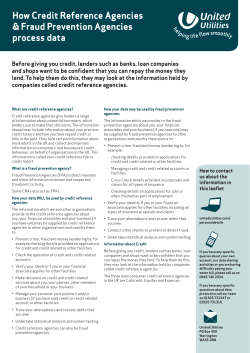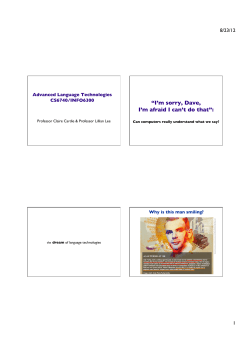
How to avoid being duped by bad check fraud:
How to avoid being duped by bad check fraud: Dan Pinnington Pinnington’s s Show Notes Digital Edge Podcast July, 2012 Where emails to fraudinfo@lawpro.ca originate* 3 Panama: 1 Portugal: 1 Czech: 1 Nigeria: 1 India: 1 Cyprus:2 Hungary:1 Romania:1 Barbados:2 Bali:1 Hawaii: 11 1 2 Mexico: 6 3 Argentina: 3 UK: 24 55 24 France: 5 10 5 Spain: 8 1,455 Holland: 7 33 Germany 7 Italy: 2 7 Bulgaria: 1 Ukraine: 3 Turkey: 4 12 166 Norway: 2 Sweden: 1 Malaysia: 2 Hong Kong: 1 Australia: 6 New Zealand: 1 18 7 4 14 24 27 Slovakia: 3 Finland: 4 3 3 5 Croatia: 1 3 5 65 59 45 42 56 28 3 2 15 4 29 17 8 5 3 1022 9 87 7 4 8 11 127 Fr. Polynesia: 2 Philippines: 1 Puerto Rico: 1 Poland: 1 © 2012 Lawyers’ Professional Indemnity Company 4 33 (NJ) 44 (MA) 9 (CT) 1 (DE) 8 (VT) 8 (RI) 23 (MD) 11 (DC) 3 (NH) Bahamas: 1 Virgin Islands: 2 1 1 45 *based on approximately 2,800 emails received from January 2011 to June 2012 June ‘12 1 Sample fake ID documents Sample fake passports © 2012 Lawyers’ Professional Indemnity Company 2 Sample fake checks Sample documents • A huge collection of fake IDs, documents and cheques given to lawyers by fraudsters: http://avoidaclaim.com/?page_id=2395 • Collaborative Law Participation Agreement fraud documents – Collaborative law participation agreement: http://avoidaclaim.com/wpcontent/uploads/2011/08/Masaru-Collaborative-Agreement.pdf – Divorce decree: http://avoidaclaim.com/wp-content/uploads/2011/08/MasaruDivorce-Decree.pdf – Settlement agreement: http://avoidaclaim.com/wpcontent/uploads/2011/08/Masaru-Settlement-Agreement.pdf p g p – “I’m sorry, I’m paying” letter http://avoidaclaim.com/wpcontent/uploads/2012/02/Brewer-cheque-cover.jpg © 2012 Lawyers’ Professional Indemnity Company 3 Sample documents (cont.) • • • • • • • • Payment receipts http://avoidaclaim.com/wpcontent/uploads/2011/10/Chao-PHILIP-RECEIPT1.jpg Verifications of identity http://avoidaclaim.com/wpcontent/uploads/2011/10/DLC-Solicitors.jpg Company registrations http://avoidaclaim.com/wpcontent/uploads/2011/10/DVT-TRADING-LTD.-REGISTRATION.jpg Invoices http://avoidaclaim.com/wp-content/uploads/2011/10/Liu-Lankominvoice.jpg Bank statements http://avoidaclaim.com/wpcontent/uploads/2011/10/Kazuhiro-proof-of-funds.jpg p p jpg Powers of attorney http://avoidaclaim.com/wp-content/uploads/2011/10/LiuLankom-POA.jpg Commercial letter of agreement: http://avoidaclaim.com/wpcontent/uploads/2012/06/Burger-agreement.jpg Signed retainer agreement: http://avoidaclaim.com/wpcontent/uploads/2012/04/Zimmerman-retainer.jpg Examples of multiple contacts • Sample of a long, detailed back and forth emailil conversation ti with ith a ffraudster d t http://avoidaclaim.com/?p=3052 • Another ongoing fraud conversation, this one with a voice recording http://avoidaclaim.com/?p 1780 http://avoidaclaim.com/?p=1780 © 2012 Lawyers’ Professional Indemnity Company 4 The common red flags • Initial contact email is generically addressed (e g “Dear (e.g., Dear attorney attorney”)) and BCC’d BCC d to many people. • The name in the sender email address and name in the body of the email are different. • Sender email address is different from email address mentioned in body of the email email. • Client uses one or more email addresses from a free email service (e.g., Gmail,MSN, Yahoo!), even when the matter is on behalf of a business entity. The common red flags (cont.) • Client raises issues of conflicts or payment of a retainer. retainer • Domain name used in personalized email address or website was recently registered (check at WhoIs.net). • IP address in metadata of email indicates sender is in a geographic location that is different from where he/she claims to be. • Client is new to your firm. • Client is in a distant jurisdiction. © 2012 Lawyers’ Professional Indemnity Company 5 The common red flags (cont.) • Client shows up and wants the matter completed around banking holidays holidays. • Client says they prefer email communication due to time zone differences. • Client provides only a cell number. • Client is in a rush – and pressures you to “do the d l” quickly. deal” i kl • Client and others involved don’t seem concerned if shortcuts are taken. The common red flags (cont.) • Client is willing to pay higher-than-usual fees on a contingent g basis from ((bogus) g ) funds yyou are to receive. • Despite the client stating a lawyer is needed to help push for payment, the debtor pays without any hassle. q or bank draft arrives at yyour office in • Cheque plain envelope and/or without covering letter. • Cheque is drawn from the account of an entity that appears to be unrelated (i.e., a spousal arrears payment from a business entity). © 2012 Lawyers’ Professional Indemnity Company 6 The common red flags (cont.) • Payment amounts are different than expected or change without explanation explanation. • Client instructs you to quickly wire the funds to an offshore bank account based on changed or urgent circumstances – E.g., health issues, sick child • Some or all of the payment is going to third party that appears unrelated to the matters. More information on fraud • Check confirmed names of fraudsters and see samples of real messages and documents from fraudsters on the AvoidAClaim.com blog • Use LAWPRO’s Fraud Fact sheet to educate your firm staff and lawyers about these frauds and the red flags to watch for • Report suspicious matters to fraudinfo@lawpro.ca • See more info on fraud at www.practicepro.ca/fraud www practicepro ca/fraud © 2012 Lawyers’ Professional Indemnity Company 7 Contact Info Dan Pinnington, BSc, LLB/JD Vice President, Claims Prevention & Stakeholder Relations Lawyers’ Professional Indemnity Company (LAWPRO) Lawyers Toronto, Ontario (416) 598-5863 or 1-800-410-1013 dan.pinnington@lawpro.ca www.practicepro.ca and www.lawpro.ca Blogs: g AvoidAClaim.com; slaw.ca Connect with me: – LinkedIn: Dan Pinnington – Twitter: danpinnington – Google+: Dan Pinnington © 2012 Lawyers’ Professional Indemnity Company 8
© Copyright 2025



















